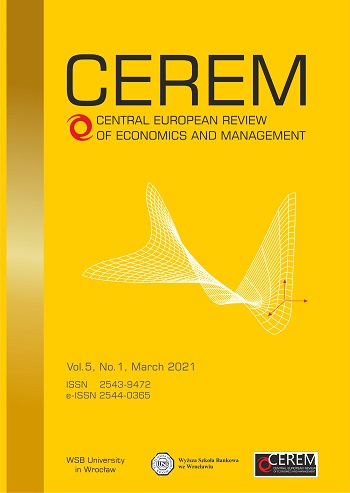European Banking Union – an institutional analysis
DOI:
https://doi.org/10.29015/cerem.896Słowa kluczowe:
European Union, Banking Union ,European Central Bank, Single Supervisory Mechanism, Single Resolution Mechanism, Deposit Insurance SchemeAbstrakt
Aim: The Banking Union is an important step towards a genuine Economic and Monetary Union. The strengthening of the European banking system has become a topic of debate since the 2008 crisis when it became clear that stability and security of the system security may require increased supervision over operations conducted. The Banking Union was created to avoid the situation that taxpayers are first in line to pay for bailing out ailing banks. The Banking Union consists of three pillars: 1) the Single Supervisory Mechanism (SSM), which centralizes supervision of European banks around the European Central Bank, 2) the Single Resolution Mechanism (SRM), which the main purpose is to ensure the efficient resolution for recapitalization failing banks, and 3) the European Deposit Insurance Scheme (EDIS), which is still unfinished. The creation of the Banking Union is accompanied by a remarkable transfer of sovereignty to the European level. This article aims to provide an overview of the changes unfolding across the Banking Union from a law and economics perspective and to explain the role of the European Central Bank in supervision over the banking system, which is different from the policy of controlling prices through determining the level of interest rates and keeping inflation under control.
Design/Research methods: The analysis of the functioning Banking Union is based on the review of literature and analysis of reports and legal acts.
Findings: The Banking Union supports financial integration in the EU by implementing a common set of rules and a common supervisory and resolution mechanism. The creation of the Deposit Insurance Scheme is likely to contribute to the protection of banks and consumers in case of a potential future crisis. The author argues that the European Central Bank as a supervisor of the financial market should create a second supervisory body, which would significantly strengthen the system and allow the ECB more efficiently fulfill its task as chief supervisor.
Bibliografia
Alexander K. (2012), European Banking Union. Implementation challenges. Inquiry on European Banking Union, “Journal of Corporate Law Studies”, no. 9, pp. 61-93.
Boyer P., Ponce J. (2012), Regulatory capture and banking supervision reform, “Journal of Financial Stability”, vol. 8 no. 3, pp. 206-217.
European Banking Federation (2019), Banking in Europe. Facts and figures, https://www.ebf.eu/wp-content/uploads/2020/01/EBF-Facts-and-Figures-2019-Banking-in-Europe.pdf [12.12.2020].
Carmassi J., Dobkowitz S., Evrard J., Parisi L., Silva A., Wedow M. (2018), Completing the Banking Union with a European Deposit Insurance Scheme. Who is afraid of cross-subsidisation?, European Central Bank, Occasional Paper Series, https://www.ecb.europa.eu/pub/pdf/scpops/ecb.op208.en.pdf [12.12.2020].
European Central Bank (ECB) (2021), Strategy, https://www.ecb.europa.eu/mopo/strategy/html/index.en.html [12.01.2021].
Ferran E. (2014), European Banking Union and the EU Single Financial Market. More differentiated integration or disintegration?, University of Cambridge Faculty of Law Research Paper no. 29.
Gerdesmeijer D. (2009), Price stability: why is it important for you? ECB, https://www.ecb.europa.eu/pub/pdf/other/whypricestabilityen.pdf [12.01.2021].
Gortsos C. (2015), The crisis-based EU financial regulatory intervention. Are we on the top of prudential wave?, “ERA Forum Journal of Academy of European Law”, vol. 16 no. 1, pp. 89-110, http://link.springer.com/article/10.1007/s12027-015-0375-2 [12.12.2020].
Grunewald S. (2014), The resolution of cross-border banking crisis in the European Union, Kluwer Law International, Alphen aan den Rijn.
Hertig A. (2012), Central Bank Governance, “Swiss Review of Business and Financial Market Law”, vol. 84 no. 6, pp. 486-493.
Howarth D., Quaglia L. (2014), The steep road to European Banking Union. Constructing the Single Resolution Mechanism, “Journal of Common Market Studies”, vol. 52, pp. 125-140, https://onlinelibrary.wiley.com/doi/10.1111/jcms.12178 [12.01.2021].
Jochnik K., Adams T. (2020), COVID-19: recovery and regulatory response, The 7 Annual European Banking Union Colloquium, European Central Bank, https:/www.bankingsupervision.europa.eu [20.01.2021].
Smits R. (1997), The European Central Bank. Institutional aspects, Kluwer International, Alphen aan den Rijn.
Van Rompuy H. (2012), Towards a genuine economic and monetary union, EUCO 120/12, https://www.consilium.europa.eu/media/33785/131201.pdf [27.03.2021].
Walker G. (2014), European Banking Law. Policy and program construction, British Institute of International and Comparative Law, London.
Węcławski J. (2015), Unia bankowa jako element europejskiej sieci bezpieczeństwa finansowego, „Zeszyty Naukowe Uniwersytetu Marii Curie-Skłodowskiej”, vol. XLIX no. 2, pp. 233-246.
Pobrania
Opublikowane
Numer
Dział
Licencja
Autor przenosi nieodpłatnie na Wyższą Szkołę Bankową we Wrocławiu , bez ograniczeń terytorialnych, majątkowe prawa autorskie do tego utworu w rozumieniu ustawy z dnia 4 lutego 1994 roku o prawie autorskim i prawach pokrewnych ( Dz.U. 1994, Nr 24, poz. 83 ze zm. )na zasadzie wyłączności, tj. prawo do:
a) wyłącznego używania i wykorzystania utworu w dowolnej działalności przez Wyższą Szkołę Bankową we Wrocławiu, w szczególności w działalność Biblioteki Cyfrowej uruchomionej przez Wyższą Szkołę Bankową we Wrocławiu
b) wytwarzania, utrwalania i zwielokrotniania egzemplarzy utworów wszelkimi technikami, w tym techniką drukarską, reprograficzną, zapisu magnetycznego oraz techniką cyfrową, w szczególności ich zwielokrotniania poprzez dokonywanie zapisów na płytach typu CD,
c) zamieszczenia wybranych fragmentów utworu w celach promocyjnych w publikacjach, materiałach promocyjnych, w sieci Internet oraz sieciach wewnętrznych typu Intranet Wyższej Szkoły Bankowej we Wrocławiu,
d) wprowadzania utworu do pamięci komputera Wyższej Szkoły Bankowej we Wrocławiu,
e) kopiowania i powielania utworu w technologiach fotomechanicznych lub innych znanych w dniu zawarcia umowy (fotokopie, kserokopie itp.),
f) przetworzenia dzieła na formę elektroniczną i nieograniczonego rozpowszechniania w sieci Internet.


